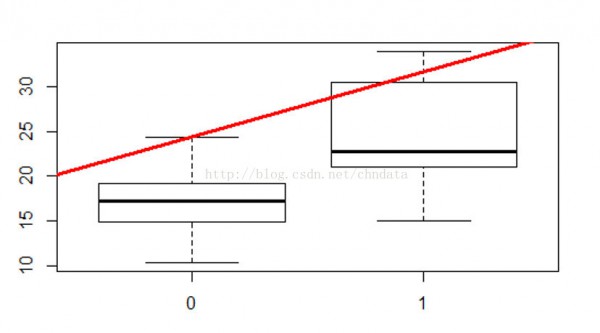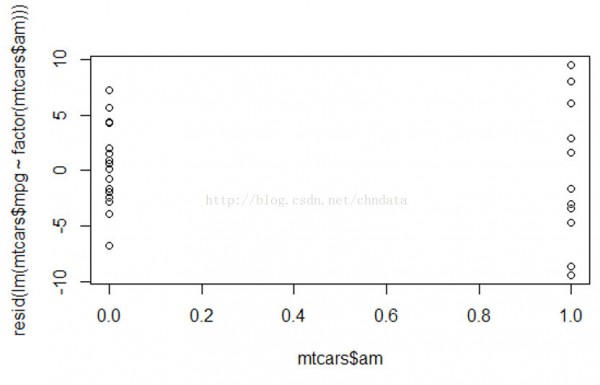这是1个多元回归方程用于揭露汽车油耗和汽车属性之间的关系,试图回答常见的问题:是不是自动档的汽车更费油?除自动档这个属性,还有其他属性和汽车耗油之间的关系更大吗?原文见于RPubshere.
分析基于R语言,mtcars小数据集(可以扩大到更大数据集),希望对读者有所帮助。
In this part, we setup a regression model between transmissions and MPG. And below are the first 6 records of data.

## Valiant 18.1 6 225 105 2.76 3.460 20.22 1 0 3 1
There's obvious difference between these 2 variables compared their highest, mean and lowest value pairs. On any level, the manual transmission cars has a bigger MPG value.(0 for automatic and 1 for manual).
And We could also find the trend has a positive slope that means when transmission increases one unit(from 0 to 1), or to say from automatic to manual, the MPG value will increase.
Quantitative Difference
fit=lm(mtcars$mpg~factor(mtcars$am))
fit
##
## Call:
## lm(formula = mtcars$mpg ~ factor(mtcars$am))
##
## Coefficients:
## (Intercept) factor(mtcars$am)1
## 17.147 7.245
Here, the intercept 17.147 is a virtual value when the regression model created, which can be regarded as a meaningless value used only for model creation(transmission equals negative value), and the slope 7.245 means every one unit increase of transmission
will beget 7.245 units increase of MPG, or to say manual transmision cars has a higher MPG 7.245 than the automatic cars in general.
Getting a confidence interval
sumCoef <- summary(fit)$coefficients
sumCoef[2,1] + c(⑴, 1) * qt(.975, df = fit$df) * sumCoef[2, 2]
## [1] 3.64151 10.84837
It shows the 95% confidence is 3.64151~10.84837, that make us confident for the conclusion that manual transmission have a higher MPG than automatic ones.
Residual Plot and diagnostic
Now, draw a residual point plot.
plot(mtcars$am, resid(lm(mtcars$mpg ~ factor(mtcars$am))))

As the plot shows both transmissions have a very scattered (⑴0,10 for manual ) or (⑺.5,7.5 automatic) residual, which means our model may be influenced by other variables and let's do more research.
Analysis phase II:
Now, we try to introduce other variables along with transmission. Since if the number of variables is greater than 2 will confuse customers rather than help them, so our purpose is finding one of the most useful variable along with transmission. #### Variables
choosen Here are all variables that could influence MPG.
wt - Car Weight (lb/1000)
gear - Number of forward gears
carb - Number of carburetors
hp - Gross horsepower
cyl - Number of cylinders
Create models based on transmission plus one more variable
fit0<-lm(mpg ~ factor(am) , data = mtcars)
fit1<-lm(mpg ~ factor(am)+wt , data = mtcars)
fit2<-lm(mpg ~ factor(am)+gear , data = mtcars)
fit3<-lm(mpg ~ factor(am)+carb , data = mtcars)
fit4<-lm(mpg ~ factor(am)+hp , data = mtcars)
fit5<-lm(mpg ~ factor(am)+factor(cyl) , data = mtcars)
Get significance value of each variable
at1<-anova(fit1);at2<-anova(fit2);at3<-anova(fit3);at4<-anova(fit4);at5<-anova(fit5)
Show P-Value results
For those variable with P-value >5%, that means it's not significant to be introduced with the better fitted model.
at1$Pr[2];at2$Pr[2];at3$Pr[2];at4$Pr[2];at5$Pr[2]
## [1] 1.867415e-07
## [1] 0.9651278
## [1] 2.752235e-06
## [1] 2.920375e-08
## [1] 8.010109e-07
From the result, we know all 4 variables may influence MPG except the second one gear.
Fit he best model
summary(fit1)$coef;summary(fit3)$coef;summary(fit4)$coef;summary(fit5)$coef
## Estimate Std. Error t value Pr(>|t|)
## (Intercept) 37.32155131 3.0546385 12.21799285 5.843477e⑴3
## factor(am)1 -0.02361522 1.5456453 -0.01527855 9.879146e-01
## wt ⑸.35281145 0.7882438 ⑹.79080719 1.867415e-07
## Estimate Std. Error t value Pr(>|t|)
## (Intercept) 23.145836 1.294133 17.885213 3.315382e⑴7
## factor(am)1 7.653119 1.222958 6.257873 7.870255e-07
## carb ⑵.191748 0.377814 ⑸.801129 2.752235e-06
## Estimate Std. Error t value Pr(>|t|)
## (Intercept) 26.5849137 1.425094292 18.654845 1.073954e⑴7
## factor(am)1 5.2770853 1.079540576 4.888270 3.460318e-05
## hp -0.0588878 0.007856745 ⑺.495191 2.920375e-08
## Estimate Std. Error t value Pr(>|t|)
## (Intercept) 24.801852 1.322615 18.752135 2.182425e⑴7
## factor(am)1 2.559954 1.297579 1.972869 5.845717e-02
## factor(cyl)6 ⑹.156118 1.535723 ⑷.008612 4.106131e-04
## factor(cyl)8 ⑴0.067560 1.452082 ⑹.933187 1.546574e-07
Interpreter of the best second variable.
Based on the results from all 4 variables, the weight variables even reverse the effect of transmission so it could be removed from our model. The 3rd one carb doesn't impact the transmission so obviously (in this case, the transmission slope is about 7, same
as the original model contains only one variable transmission), the 4th hp have a very small influence with very small slope, while the last variable cyl does impact much, its slope is smaller than ⑹ (for different number of cylinders, their slopes are ⑹.16
and ⑴0.07) . That means the number of cylinders are significant for MPG and the more number of cylinders, the lower MPG it gets.
Conclusion
Now we could answer the most asked question confidently, the manual transmission will really get a higher MPG, besides this concern, cars with smaller Number of cylinders will get higher MPG as well. Hope it helps when you are choosing your car.
结论:
自动挡汽车确切比手动挡更耗油,除这个参数,汽缸数量越多也更加耗油。
Appendix:
Whole data view of our data set:
mtcars
mpg cyl disp hp drat wt qsec vs am gear carb
Mazda RX4 21.0 6 160.0 110 3.90 2.620 16.46 0 1 4 4
Mazda RX4 Wag 21.0 6 160.0 110 3.90 2.875 17.02 0 1 4 4
Datsun 710 22.8 4 108.0 93 3.85 2.320 18.61 1 1 4 1
Hornet 4 Drive 21.4 6 258.0 110 3.08 3.215 19.44 1 0 3 1
Hornet Sportabout 18.7 8 360.0 175 3.15 3.440 17.02 0 0 3 2
Valiant 18.1 6 225.0 105 2.76 3.460 20.22 1 0 3 1
Duster 360 14.3 8 360.0 245 3.21 3.570 15.84 0 0 3 4
Merc 240D 24.4 4 146.7 62 3.69 3.190 20.00 1 0 4 2
Merc 230 22.8 4 140.8 95 3.92 3.150 22.90 1 0 4 2
Merc 280 19.2 6 167.6 123 3.92 3.440 18.30 1 0 4 4
Merc 280C 17.8 6 167.6 123 3.92 3.440 18.90 1 0 4 4
Merc 450SE 16.4 8 275.8 180 3.07 4.070 17.40 0 0 3 3
Merc 450SL 17.3 8 275.8 180 3.07 3.730 17.60 0 0 3 3
Merc 450SLC 15.2 8 275.8 180 3.07 3.780 18.00 0 0 3 3
Cadillac Fleetwood 10.4 8 472.0 205 2.93 5.250 17.98 0 0 3 4
Lincoln Continental 10.4 8 460.0 215 3.00 5.424 17.82 0 0 3 4
Chrysler Imperial 14.7 8 440.0 230 3.23 5.345 17.42 0 0 3 4
Fiat 128 32.4 4 78.7 66 4.08 2.200 19.47 1 1 4 1
Honda Civic 30.4 4 75.7 52 4.93 1.615 18.52 1 1 4 2
Toyota Corolla 33.9 4 71.1 65 4.22 1.835 19.90 1 1 4 1
Toyota Corona 21.5 4 120.1 97 3.70 2.465 20.01 1 0 3 1
Dodge Challenger 15.5 8 318.0 150 2.76 3.520 16.87 0 0 3 2
AMC Javelin 15.2 8 304.0 150 3.15 3.435 17.30 0 0 3 2
Camaro Z28 13.3 8 350.0 245 3.73 3.840 15.41 0 0 3 4
Pontiac Firebird 19.2 8 400.0 175 3.08 3.845 17.05 0 0 3 2
Fiat X1⑼ 27.3 4 79.0 66 4.08 1.935 18.90 1 1 4 1
Porsche 914⑵ 26.0 4 120.3 91 4.43 2.140 16.70 0 1 5 2
Lotus Europa 30.4 4 95.1 113 3.77 1.513 16.90 1 1 5 2
Ford Pantera L 15.8 8 351.0 264 4.22 3.170 14.50 0 1 5 4
Ferrari Dino 19.7 6 145.0 175 3.62 2.770 15.50 0 1 5 6
Maserati Bora 15.0 8 301.0 335 3.54 3.570 14.60 0 1 5 8
Volvo 142E 21.4 4 121.0 109 4.11 2.780 18.60 1 1 4 2

上一篇 病毒整理